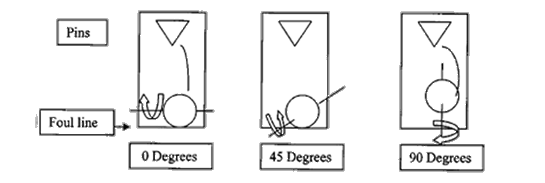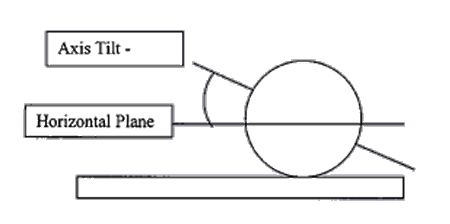The Effect from Different Hand Positions
By Danny Speranza,
900Global Director of Product Research
Axis of Rotation - (example, 0, 45, and 90 degrees) This is a measure of the direction of the initial rotation on the ball with respect to the lane. It is a measurement of the angle between the initial spin axis and the foul line running across the lane. A zero degree axis of rotation is all forward roll. The rotation on the ball is in the direction of the forward travel. The rotation will help keep the ball in the initial direction. The ball will not hook very much. It will roll out early. Therefore, a bowler with this style will need balls drilled to go long.
A 90-degree axis of rotation is all side roll. The rotation is
perpendicular to the initial direction. The rotation is trying
to make the ball hook at a 90-degree angle to the initial direction.
This gives the ball more potential to hook. This style causes the
ball to skid further down the lane and then hook more. A bowler
with this style will most likely need balls drilled to hook earlier,
such as, axis weight or pins closer to their axis.

Axis Tilt - (example, a spinner versus a full roller) This is
a measure of the angle of the initial spin axis to a horizontal
plane. A full roller or high track style would have little or no
axis tilt. The initial spin axis would be parallel or close to
parallel with the lane surface. One rotation of the ball would
cover the major diameter of the ball. A spinner would have an initial
spin axis tilted up from the lane. The ball track would be far
away from the thumb and finger holes. One rotation of the ball
would cover a much smaller diameter than other bowlers. The spinner
style will get the ball further down the lane before it hooks.

Different hand positions can alter the axis rotation angle. With everything else held the same, the simulator shows a dramatic difference in the resulting ball path from just changing the axis rotation angle in the example above.
0-Degree Axis of Rotation Angle:
The ball is rotating about
the white tape on the left side of the ball. The hand releases
the ball from directly behind the ball keeping the rotation axis
direction on the side of the ball. This location is defined as
a 0-degree axis rotation angle (parallel to the foul line). The
rotation on the ball is trying to take the ball straight down the
lane which is in the same direction as the forward velocity. The
resulting ball direction will be the sum of the forward velocity
and rotational forces which are in the same direction, so the ball
will not change direction. It will not hook but rather go dead
straight. Even if more rotation (RPM’s)
is added to the ball from the bowler, it will not hook.
90-Degree Axis of Rotation Angle:
The other extreme in hand
position is the 90-degree axis rotation release. With a 90-degree
axis rotation angle the initial rotation axis is at 90-degrees
to the foul line. The hand has to rotate all the way to the side
of the ball at the release position which is next to the slide
leg. This faces the spin axis (white tape) straight back. Bowlers
refer to this hand release as creating side turn. The ball is again
rotating around the white tape on the back of the ball and this
rotational force is trying to take the ball straight across the
lane in the direction of the arrow. So, if there was only this
rotational force on the ball with no forward velocity, the ball
would travel straight across the lane to the left in the direction
of the arrow. Now, when we apply forward velocity along with this
rotation, the ball will initially travel straight down the lane
due to low friction created by the oil on the lane and then hook
sharply down the lane once it leaves the oil. The ball is trying
to go in a direction which is the sum of the forward velocity and
the rotation. The resulting final direction will be somewhere between
the initial forward velocity and the 90-degree axis of rotation
direction.
45-Degree Axis of Rotation Angle:
The next hand position
is the 45-degree axis rotation direction. The hand is located half
way to the outside of the ball. This creates a lot more change
in the ball direction down the lane than the 0-degree axis of rotation
angle but less than the 90-degree release. By only changing the
hand position at the release point between the 30-degree and 90-degree
hand positions, the result would be an 8 board difference in total
hook and a 4+ degree difference in the entry angle.
If we use the Ball Path Simulator again and make the ball paths for the different axis rotation angles end up hitting the strike pocket, the ball path differences can be seen below:
The 90-degree axis of rotation angle shows the ball path traveling the furthest down the lane with the sharpest change of direction on the backend. The 30-degree axis of rotation angle hooks the earliest with the least entry angle. Both will work at different times on different oil patterns.
How to add this to your game
Altering the Axis Rotation Angle is a great feature to add to your game. I have notice the PBA bowlers doing this a lot on television especially in the last few years. Chris Barnes can hook the entire lane if he elects to. But, lately he has reduced the axis of rotation angle, so he could go more direct to take advantage of the lane condition. Norm Duke is an expect at manipulation this part of his game.
It is not very difficult to learn to alter this axis of rotation angle. Start by plugging and re-drilling one of your old balls with the pin on the positive axis point for this exercise. This will make the ball rotate around the pin as it travels down the lane. This is a stable drilling for the core position in the ball, so the ball track will not flare. Now place a piece of white tape on the pin so you can see it when you bowl. The tape will remain on the axis point over the entire ball path. This ball will not hook very much, but the goal is to learn how to manipulate the initial axis rotation angle when the ball leaves your hand. Throw the ball with your normal delivery and see where the tape is located. Then try to release the ball with your hand staying behind the back of the ball to reduce the axis of rotation angle to create a sooner break point and less overall hook. Next, try to rotate your hand around the outsides of the ball (away from your body) at the release point for get more axis of rotation angle. This will bring the white tape to the back of the ball at the release point. This will make the ball travel further down the lane with a sharp backend reaction for more hook and entry angle. Learning to make these adjustments will add versatile to your game on different oil patterns. Normally, the straighter you up down the boards, less axis of rotation angle will work better. The deeper inside you play as the oil dries up, the increased axis of rotation angle will get the ball to recover better from the break point to the pocket.
allikas: 900Global.com
